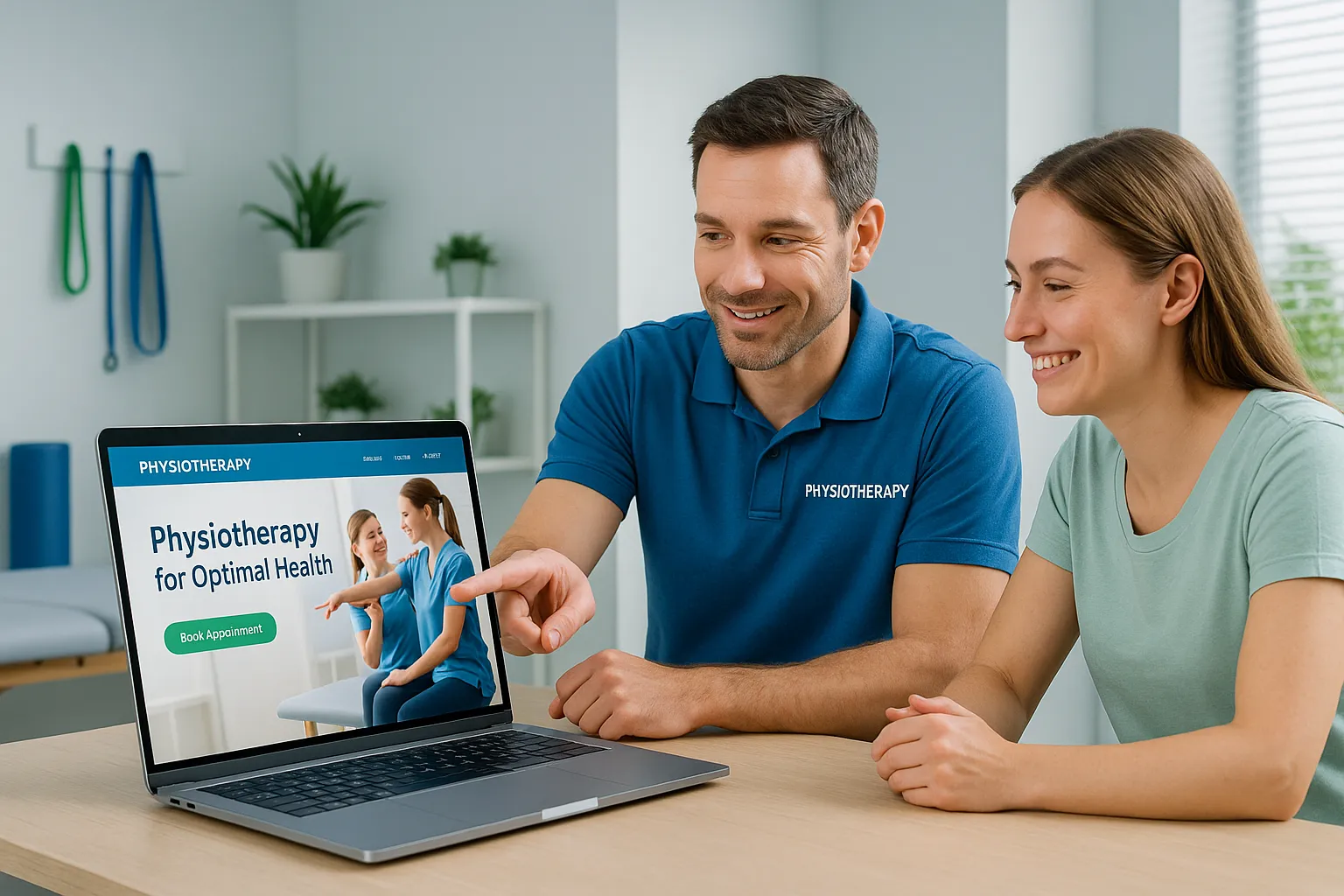
Rated Excellent by the Customers ★ ★ ★ ★ ★

How Do I Market Myself as a Physical Therapist?
- June 11, 2025
The Importance of Standing Out in a Competitive Market
Physical therapists are vital members of the healthcare team, helping patients recover, reduce pain, and regain their quality of life. But in today’s highly competitive market, being a skilled professional may not be enough to bring people to your door. With numerous physical therapists, clinics, and allied health services available, marketing yourself effectively has become a crucial part of building a sustainable and thriving career.
No matter your current situation – whether you’re an independent practitioner, part of a group practice, or even newly qualified – strategic marketing can build your reputation, attract new clients, and foster trust within your community. Marketing isn’t about gimmicks; it’s about showcasing your expertise, connecting with the people you can help most, and positioning yourself as a go-to professional in your field.
Start Thinking Like a Brand
Successful marketing starts with building your brand. As a physical therapist, your name, skills, reputation, and values are your brand. This goes beyond just having business cards or a logo—it’s how people perceive you, how much they trust you, and how likely they are to recommend you to others. A strong brand enables you to stand out, communicate your passion, and foster relationships with both current and future clients.
Your brand should answer these critical questions:
– Who are you as a professional?
– What makes you unique in the field of physical therapy?
– How can you add value to your clients’ lives?
– Why should someone choose you over other therapists?
If you take the time to define your brand and clarify these points, every marketing effort you put forth will feel authentic, focused, and purposeful.
Creating Connections in a Digital Age
With the rise of online platforms, the way people interact with healthcare providers has undergone a significant shift. Patients are researching providers online before ever stepping foot into a clinic. They’re reading reviews, viewing social media profiles, and comparing options based on credibility and convenience. As a physical therapist, building a strong digital presence enables you to connect with local audiences, educate potential clients, and establish your authority in the field.
However, marketing isn’t confined solely to the digital world. Building personal connections—through professional networking, local events, and community involvement—remains indispensable. Combining traditional marketing strategies with modern digital tools is the ultimate recipe for success.
Why Marketing Yourself Requires a Holistic Approach
Marketing is not a one-size-fits-all exercise. Depending on your goals, community, and target audience, you will need to tailor your approach to suit your specific situation. A holistic approach involves:
1. Building visibility within your target community.
2. Sharing expertise and educating your audience.
3. Creating client relationships that foster trust and long-term loyalty.
4. Showcasing your skills and services in a way that feels approachable and professional.
Done well, marketing doesn’t just bring clients into your practice—it builds credibility in your industry, strengthens connections with referral partners, and enhances your professional reputation over the long term.
Now, let's break it all down step by step. Here are answers to frequently asked questions that will guide you in marketing yourself effectively as a physical therapist.
Personal branding is about getting people to know, trust, and choose you over others. By defining your niche, showcasing your skills, and highlighting patient outcomes, you can position yourself as an expert in your field. A strong personal brand attracts more clients, fosters long-term relationships, and earns credibility among key referral sources, such as doctors and other professionals.
Your online presence is your digital reputation. Here’s how to stand out:
- Create a personal website or blog: Include your qualifications, specialties, and success stories. Offer helpful tips, such as injury prevention advice, to show your value to prospective clients.
- Be active on social media: Share educational content, videos of simple exercises, or rehab tips on platforms like Instagram, Facebook, or LinkedIn. Use stories and reels to engage your audience.
- Claim your Google My Business profile: Ensure potential clients can easily find you in local searches. Optimize your profile with accurate information, working hours, and client reviews.
- Leverage reviews: Ask satisfied clients to leave positive feedback on your website, Google, or Yelp. Displaying reviews builds trust and reassures prospective clients.
Building connections in your community amplifies your reach and credibility:
- Partner with healthcare providers: Connect with orthopedic surgeons, chiropractors, and general physicians who can refer patients to you.
- Collaborate with fitness professionals: Offer workshops in local gyms, yoga studios, or sports clubs on injury prevention and recovery.
- Host free educational events: Organize webinars, talks, or live sessions to share your expertise and answer potential clients’ questions.
- Attend industry events: Participate in medical conferences, local health fairs, or networking meetups to expand your contacts.
Specialization can help you stand out in a competitive market. By concentrating on a specific treatment area, you increase the likelihood that clients seeking those services will choose you. Consider specializing in:
– Sports rehabilitation for athletes looking to recover quickly.
– Post-surgery recovery for patients who have undergone joint replacements or other procedures.
– Chronic pain management for seniors or individuals with orthopedic issues.
– Pediatric physical therapy for children recovering from injuries.
Ensure that you highlight your specialization with targeted messaging on your website, social media, and local directory listings.
Creating high-quality content is one of the most effective ways to educate your audience and establish trust. Here’s how to get started:
- Start a blog: Write about topics relevant to your audience, like “5 Tips to Manage Lower Back Pain” or “Common Sports Injuries and How to Heal Quickly.”
- Shoot short videos: Demonstrate simple exercises or stretches clients can try at home. Share these on YouTube, Instagram, or your website.
- Offer free resources: Create downloadable guides, such as “Posture Improvement Tips” or “How to Prepare for a PT Session.”
- Create email newsletters: Keep past and prospective clients engaged with regular updates, tips, and special offers.
Content marketing showcases your expertise, keeps you top-of-mind with clients, and enhances your search engine rankings.
Your visual identity plays a crucial role in how others perceive you. Here’s how to create a professional and approachable image:
- Invest in a clean, professional logo and use it consistently across your website, social media, and marketing materials.
- Use high-quality photos: Showcase yourself in action—treating patients or speaking at events. These images humanize your brand and build connections.
- Choose consistent colors and fonts: Branding elements like blue and green tones help convey trust and a sense of health.
- Share your story visually: Create a professional “About Me” video to introduce yourself, highlight your expertise, and talk about why you love helping patients.
Focusing on local marketing ensures you reach potential clients in your area. Here’s how:
- Attend community events: Sponsor local races, participate in wellness fairs, or host workshops at senior centers.
- Get listed in local directories: Include your name in healthcare directories or local business listings.
- Send direct mail campaigns: Share special offers or promotions with residents in your neighborhood.
- Collaborate with schools or sports teams: Offer physical therapy assessments or injury prevention seminars for athletes and students.
Paid ads allow you to target specific audiences and drive traffic to your services. Focus on these platforms:
- Google Ads: Run paid search campaigns targeting relevant keywords like “physical therapist near me” or “sports physical therapy.”
- Social media ads: Use Facebook and Instagram to promote your services to specific demographics based on location and interests.
- Boost your posts: Amplify content like patient testimonials, videos, or workshops to increase visibility.
Track the performance of your campaigns to optimize them for better results.
Marketing doesn’t end after you attract a client. Retention is key to steady growth. Focus on:
- Clear communication: Explain treatment plans thoroughly and address all client concerns clearly and concisely.
- Personalized care: Make each patient feel valued with tailored treatment approaches that meet their unique needs.
- Regular follow-ups: Check on progress after treatments and remind clients of follow-up appointments.
- Encourage referrals: Ask satisfied patients to refer friends or family—word of mouth is mighty.
Consistency is key. Dedicate a few hours each week to:
- Updating your website with fresh content, engaging with your audience on social media, and following up with potential collaborators or referral sources.
- Monitoring marketing analytics to refine strategies.
If time is tight, consider outsourcing to a professional marketing service, such as PhysioWebCare, for assistance with digital campaigns, website management, or social media engagement.
Introducing services has the potential to increase revenue and appeal to a range of patients so think about these possibilities;
- Offer group classes such, as balance training or postnatal recovery to cater to clients simultaneously
- Let’s incorporate wellness initiatives such, as care offerings or fitness guidance for clients without injuries who’re interested, in ongoing maintenance.
- Collaborate with companies to create wellness programs tailored to address workplace injuries or provide evaluations, on workplace ergonomics.
- Embark, on home visits; Deliver therapy services at patients residences to assist those, with mobility or living in regions.
A strong brand isn’t exclusive, to corporations; it plays a role, in how patients view and remember you shaping your identity effectively.
- Clarify your core principles. Are you positioning yourself as a family-oriented clinic focusing on sports injury care or both? Ensure this messaging is consistent, across all communication channels.
- Ensure your brand identity remains cohesive, by utilizing visuals such as the logo design and color palette, across your website, business cards, and signage to enhance recognition.
- Communicate your purpose to patients by sharing the reasons, behind your work, in your materials and messages within the clinic.
- Authenticity is key. Patients place their trust in brands that come across as genuine. Make sure to let your personality and compassion shine through.

This ebook refects the common mistakes made by physiotherapists and also provides solution on how to fix them.
Download this free ebook
Top 10 Website Mistakes Physiotherapists Make & How to Fix Them
DownloadMore Frequently asked questions.
Initial results appear within 30-60 days, with significant revenue increases typically seen within 3-6 months of implementing a comprehensive strategy.
Effective local SEO programs typically start at $500-$1,500 monthly, with most clinics seeing positive ROI within 2-3 months.
Clinics typically see 10-20 additional new patients monthly after implementing proper local SEO strategies.
Neglecting Google Business Profile optimization and consistent NAP information across platforms are the most common and costly mistakes.
Local SEO typically delivers 3-5x better ROI than traditional advertising, with more sustainable long-term results and lower patient acquisition costs.
The most engaging content for physiotherapy websites includes condition-specific treatment guides (e.g., “Complete Recovery Guide for Rotator Cuff Injuries”), before-and-after patient success stories with measurable outcomes, preventative exercise videos, specialized service explanations targeting specific demographics (like runners or seniors), and educational content about innovative treatment techniques. Research shows that websites with regularly updated, helpful content receive 55% more traffic and generate 67% more leads than static websites.
Patient testimonials build trust and credibility for your practice. They provide social proof of your effectiveness and help potential patients feel more comfortable choosing your services. Consider featuring video testimonials for a more personal touch.
You can use analytics tools like Google Analytics to track visitor behavior, page views, and conversion rates. Setting up goals for appointment bookings can give you insights into how well your website is performing in terms of patient engagement.

Website and Digital Marketing Solutions for Physiotherapists and Cancer Rehabilitation Physiotherapists
Contact Us
- info@physiowebcare.com
- I work from beaches and hills!
- Skype me for a call
Get Connected








